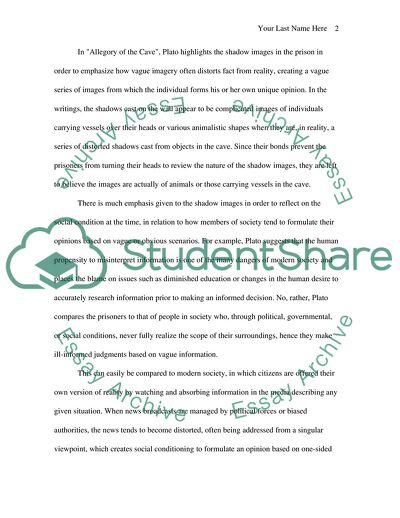
- Home
- Free Samples
- Premium Essays
- Editing Services
- Extra Tools
- Essay Writing Help
- About Us
- Studentshare
- Subjects
- Miscellaneous
- The Relationship of Individual to Society- How one's perception of reality is influenced more by society than the individual in Plato's 'The Allegory of the Cav
The Relationship of Individual to Society- How one's perception of reality is influenced more by society than the individual in Plato's 'The Allegory of the Cav - Essay Example

- Subject: Miscellaneous
- Type: Essay
- Level: Masters
- Pages: 4 (1000 words)
- Downloads: 0
- Author: domingogerhold
Extract of sample "The Relationship of Individual to Society- How one's perception of reality is influenced more by society than the individual in Plato's 'The Allegory of the Cav"
It is important to first identify the relation of broader society to how individuals interpret and act on information. Many modern psychologists and sociologists recognize that human perception is largely influenced by obvious cues and models, which are used to give meaning to the world around us (Henslin, 2003; Morris & Maisto, 2005). In modern theory, models represent various people or situations by which an individual molds their opinion and by which the person decides whether to take action (Weiten & Lloyd, 2005).
In "Allegory of the Cave", Plato highlights the shadow images in the prison in order to emphasize how vague imagery often distorts fact from reality, creating a vague series of images from which the individual forms his or her own unique opinion. In the writings, the shadows cast on the wall appear to be complicated images of individuals carrying vessels over their heads or various animalistic shapes when they are, in reality, a series of distorted shadows cast from objects in the cave. Since their bonds prevent the prisoners from turning their heads to review the nature of the shadow images, they are left to believe the images are actually of animals or those carrying vessels in the cave.
There is much emphasis given to the shadow images in order to reflect on the social condition at the time, in relation to how members of society tend to formulate their opinions based on vague or obvious scenarios. For example, Plato suggests that the human propensity to misinterpret information is one of the many dangers of modern society and places the blame on issues such as diminished education or changes in the human desire to accurately research information prior to making an informed decision.
No, rather, Plato compares the prisoners to that of people in society who, through political, governmental, or social conditions, never fully realize the scope of their surroundings,
...Download file to see next pages Read MoreCHECK THESE SAMPLES OF The Relationship of Individual to Society- How one's perception of reality is influenced more by society than the individual in Plato's 'The Allegory of the Cav
Analysis of Plato's Allegory of the Cave
Social Cognition, Social Perception, and Social Influences
Platos Defense of the Republic King in the Republic
Platos Allegory of the Cave
Platos Allegory of the Cave
Platos Allegory of the Cave
Platos Allegory of the Cave
Elegy in Sylvia Plaths Poetry

- TERMS & CONDITIONS
- PRIVACY POLICY
- COOKIES POLICY